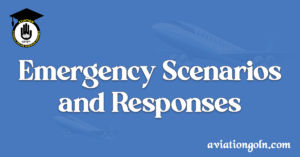Flight safety is of paramount importance in the aviation industry. With millions of people traveling by air daily, ensuring the safety of passengers, crew, and aircraft is a top priority for all stakeholders. This article delves into various emergency scenarios that might arise during flight and the standard emergency procedures implemented to handle them.
Emergency Scenarios and Responses

1. Introduction
Aviation has been considered one of the safest modes of transportation, with rigorous training, standard operating procedures, and technological advancements. However, despite all preventive measures, unforeseen emergencies can occur. Preparation for such scenarios can be the difference between tragedy and the safe conclusion of a flight.
2. Engine Failure
One of the most feared emergencies is engine failure.
Scenario: An aircraft engine can fail due to various reasons, including mechanical malfunction, bird strikes, or external damage.
Response: Pilots are trained extensively for this situation. Immediate actions include maintaining aircraft control, setting the appropriate airspeed, and determining the best course of action, whether attempting a restart or diverting to the nearest suitable airport.
3. Cabin Depressurization
Scenario: If an aircraft loses cabin pressure at cruising altitude, the lack of oxygen can become a grave concern within moments.
Response: Oxygen masks will drop automatically. Pilots would initiate an emergency descent to a safer altitude (usually below 10,000 feet) where breathable air is available.
4. Fires on Board
Scenario: Fires can occur in the engine, cockpit, or cabin due to electrical issues, engine malfunctions, or other reasons.
Response: Fire suppression systems in engines and cargo holds can be activated. In the cabin, crew members use fire extinguishers. Pilots might opt for an emergency landing.
5. Medical Emergencies
Scenario: A passenger or crew member could experience a medical emergency, such as a heart attack or severe allergic reaction.
Response: Cabin crew are trained in basic first aid and can use onboard medical kits. For serious cases, the pilot might divert to the nearest airport, and ground medical assistance would be alerted.
6. Terrorism or Unruly Passengers
Scenario: Threats can arise from individuals causing disturbances, or in worst-case scenarios, attempting to hijack the aircraft.
Response: Crew members use their training to de-escalate the situation. They have restraints for unruly passengers. In extreme scenarios, pilots may take evasive maneuvers or divert.
7. Landing Gear Malfunctions
Scenario: The landing gear fails to deploy or indicates it hasn’t locked in place.
Response: Pilots may try various maneuvers to unjam the gear. If unsuccessful, preparations are made for a belly landing, and emergency services are alerted at the landing airport.
8. Bird Strikes
Scenario: Birds can collide with aircraft, causing engine failures or damage to other critical components.
Response: If an engine is affected, pilots follow engine-out procedures. With structural damage, they evaluate the aircraft’s controllability and decide on the safest course of action.
9. Fuel Emergencies
Scenario: Due to planning errors, unexpected weather, or aircraft system malfunctions, an aircraft might run low on fuel.
Response: Pilots would declare a fuel emergency, which gives them priority for landing. They would then divert to the nearest suitable airport.
10. Adverse Weather
Scenario: Encountering unexpected severe weather, like thunderstorms or icing conditions.
Response: Pilots utilize onboard weather radar and air traffic control information to navigate around severe weather. De-icing systems are employed if ice accumulation is detected.
11. Loss of Navigation or Communication
Scenario: Aircraft loses its navigation capabilities or cannot communicate with air traffic control.
Response: Pilots follow standard lost communication procedures, which might include flying specific routes or altitudes and squawking specific transponder codes.
12. Evacuation on Ground
Scenario: After landing, an immediate threat, like fire, necessitates evacuating the aircraft.
Response: Pilots order an evacuation, and cabin crew coordinate a swift and orderly evacuation using emergency slides.
13. Water Landing
Scenario: Extremely rare, but an aircraft might have to ditch in water.
Response: Pilots attempt to touch down as smoothly as possible. Once down, cabin crew and passengers use life vests and life rafts to evacuate.
14. Conclusion
The aforementioned scenarios underscore the breadth and depth of potential emergencies in aviation. However, it’s important to remember that these events are rare due to the stringent safety measures in place. Continuous training of pilots and crew, technological advancements, and rigorous maintenance standards ensure that flying remains one of the safest ways to travel.
In the event of an emergency, the disciplined response of the flight and cabin crew, combined with the tools and procedures at their disposal, generally ensures the safety and well-being of all onboard. This comprehensive approach to flight safety, developed over many decades, will continue to evolve, always with the primary goal of ensuring the safety of air travel for all.
